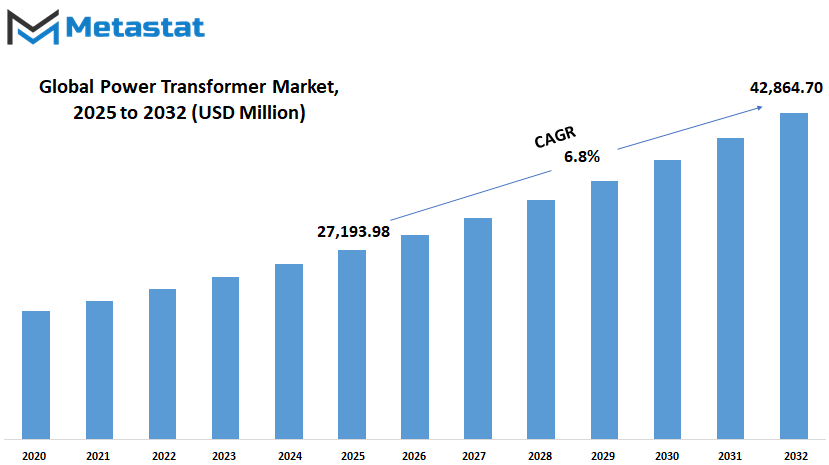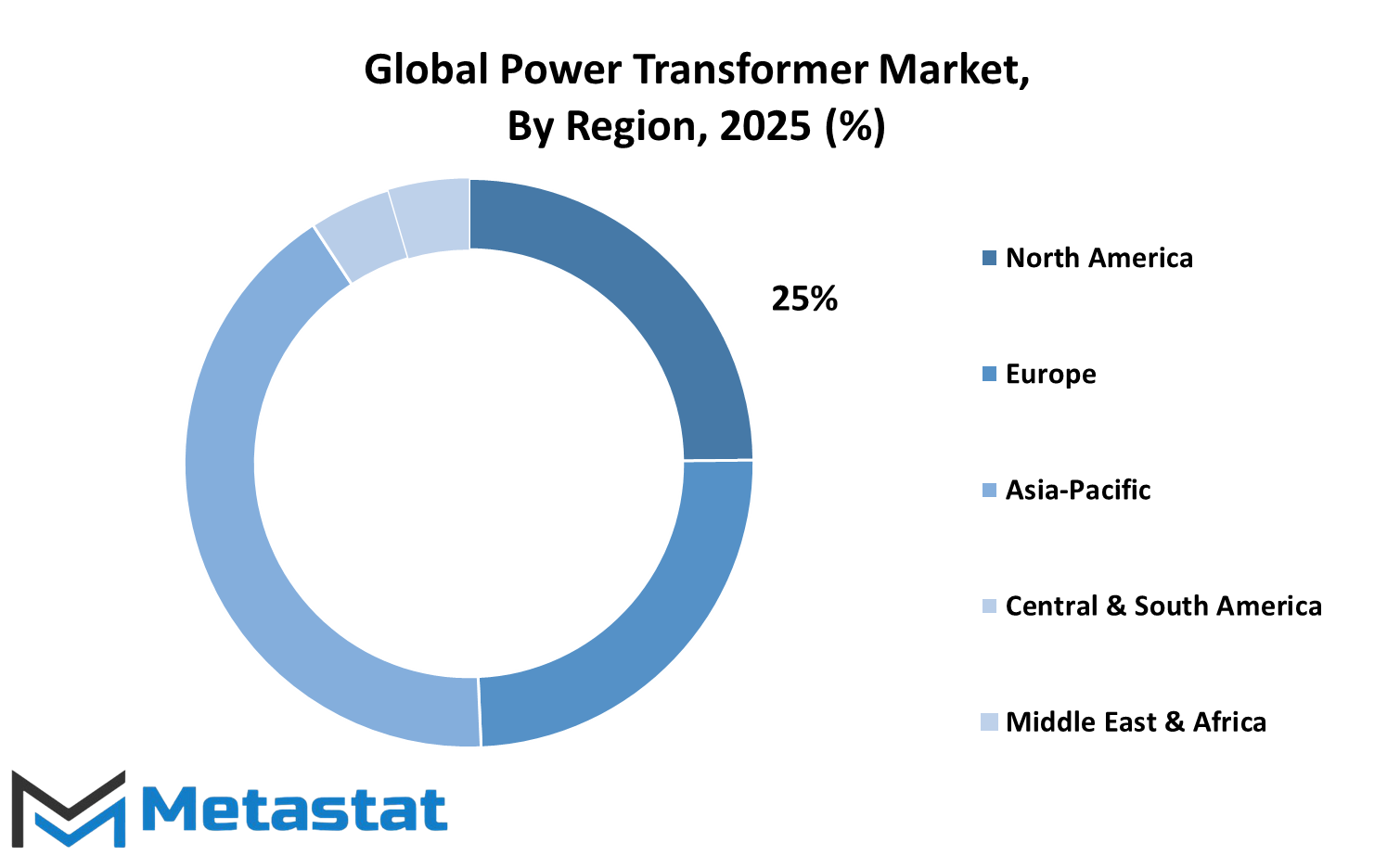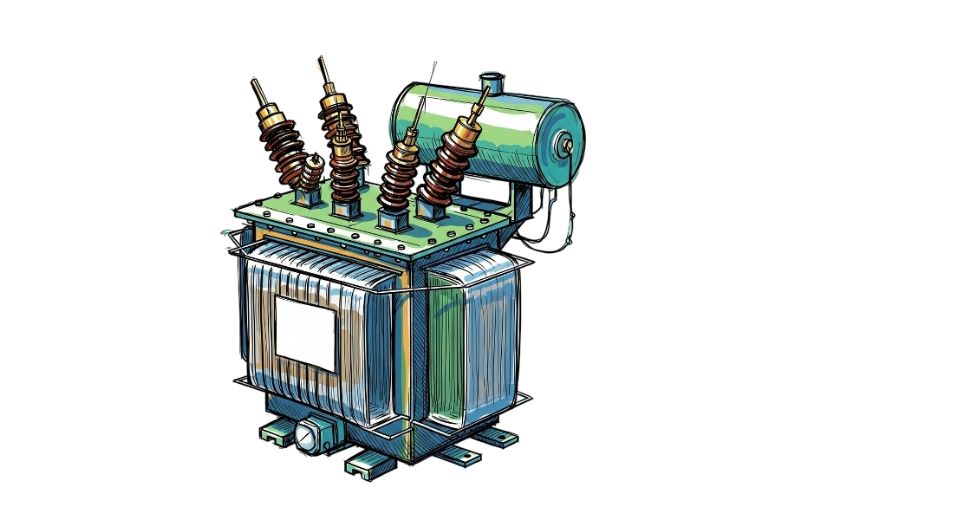MARKET OVERVIEW
The global power transformer market is a critical part of the electrical equipment sector, oriented towards high-transmission and high-distribution of power over long distances and high-voltage grids. This market will establish itself in terms of the production, installation, and maintenance of power transformers that enable energy systems to operate at maximum efficiency and low loss. These systems will remain paramount in handling load flow between interconnected grids, especially as countries invest in updating their infrastructure to accommodate urban growth and industrialization.
The global power transformer market in the coming years will be influenced by technologies that can improve operating control and integration with grid automation. Governments and private utilities will also install next-generation transformer units that are compliant with digital grid standards. Electricity transformers in this segment will differ in design and capacity, but all will do the basic job of altering voltage levels at generation and consumption points. These units will operate with high voltages, usually more than 100 MVA, and will be mounted in substations, power stations, and large transmission centers.
The range of the global power transformer market will spread from mere equipment supply to encompass installation services, diagnostic testing, lifecycle support, and monitoring solutions that guarantee best performance. Market players will create specialized transformer solutions tuned to the grid requirements of specific regions and local regulatory environments. The sector will see growing demand for units that can function under different climatic conditions, particularly from emerging markets that will expand their transmission networks.
The global power transformer market manufacturers will find a continuing focus on efficiency levels and adherence to changing international standards for energy safety and green environmental footprint. This will drive the broad adoption of environmentally friendly insulation compounds, low-noise level design, and smart monitoring functionalities integrated into transformer systems. In addition, the transformer production supply chain will comprise a broad network of component suppliers, steel fabricators, winding specialists, and test facilities, all contributing to a market that will be technically sophisticated but also economically substantial.
Energy regulators and utility companies will increasingly find themselves depending on grid-stabilizing technologies, of which high-capacity power transformers will be the foundation. As countries increase renewable power generation and link regional grids, the need for transformers that can accommodate variable load inputs and decentralized generation will grow. This diversification of grid infrastructure will keep the global power transformer market dynamic, fueled by electrical engineering innovations and strategic investments.
This market not only will fund energy infrastructure development but also cross-border electricity trade, especially across areas with seasonal variations in demand. Through providing voltage change in long distances without significant losses, these systems will provide power accessibility reliably across urban areas, rural areas, and industrial regions. As additional stakeholders continue to invest in robust grid infrastructure, the global power transformer market will emerge as an integral part of large-scale electricity distribution initiatives throughout the world.
Global power transformer market is estimated to reach $42,864.70 Million by 2032; growing at a CAGR of 6.8% from 2025 to 2032.

GROWTH FACTORS
The global power transformer market is expected to see steady growth in the coming years due to several ongoing and emerging factors. As more regions across the world experience population growth and urban development, the demand for electricity will continue to rise. This increase in electricity use is pushing countries to strengthen and expand their power grid systems to make them more reliable and capable of supporting higher loads. The need to replace old and inefficient equipment with modern and efficient systems will also add to the demand for power transformers.
Another key factor supporting the growth of this market is the increasing shift toward renewable energy sources. Many countries are investing in solar, wind, and hydroelectric power to reduce their dependence on fossil fuels. These renewable energy systems require advanced transformers to connect their output to the grid in a stable and efficient manner. As a result, the market is seeing rising interest in transformer technologies that can support this shift. In addition, smart grid systems are becoming more common. These systems help manage electricity more effectively by using digital tools and sensors. Power transformers play a critical role in making these systems work, which further boosts their demand.
However, there are some challenges that could slow down this progress. One of the major concerns is the high initial cost involved in purchasing and installing these transformers. Manufacturing these large and specialized machines takes time and requires significant investment. This can lead to long lead times, especially when demand is high or supply chains are disrupted. Moreover, the installation and upkeep of these systems can be complex. They often need highly skilled technicians and proper planning to ensure safety and efficiency. These factors may discourage smaller power companies or developing countries from upgrading their infrastructure quickly.
Despite these obstacles, there is strong potential for future growth in the global power transformer market. One of the most promising opportunities lies in the development of eco-friendly and compact transformers. These next-generation products aim to reduce environmental impact while fitting into smaller spaces, making them ideal for urban areas or renewable energy installations. As technology continues to advance and more emphasis is placed on energy efficiency and sustainability, the demand for such innovative solutions is likely to increase. This makes the market attractive for manufacturers and investors who are ready to meet the changing needs of the energy sector.
MARKET SEGMENTATION
By Product Type
The global power transformer market is expected to see important changes in the future due to growing demand for electricity, changes in energy policies, and new technology. As countries keep working toward building better energy systems, transformers will remain a key part of making sure electricity is delivered safely and efficiently. The demand for power transformers is rising because many parts of the world are seeing an increase in population, urban growth, and industrial activity. These factors push the need for stronger and more reliable electric power networks, where transformers play a central role.
Power transformers help move electricity over long distances by changing voltage levels. They make sure the energy produced at power plants can reach homes, factories, and other users. The market is growing not only in developed countries, where aging infrastructure needs upgrades, but also in developing countries that are building new power systems to meet rising energy demands. Governments and private companies alike are putting more money into modernizing the grid, and this is helping the power transformer market expand.
Looking at the global power transformer market by product type, there are two main categories Core and Shell. Core-type transformers are more commonly used and are designed in a way that allows electricity to move through a magnetic core with the winding around it. These are preferred for handling large amounts of electricity and are known for their ability to lower energy loss. Shell-type transformers, on the other hand, have the winding placed inside the core and offer better protection and efficiency in certain cases. They are especially helpful in places where space is limited or where transformers are exposed to more stressful environments.
In the future, the development of smart grids and cleaner energy sources like solar and wind will have a strong impact on the transformer market. These new energy systems need transformers that are not only reliable but also smarter and more adaptable. This means more investment will go into designing transformers that can handle changing loads, work with digital control systems, and operate with less maintenance. Companies are also working on using better materials and designs that can help transformers last longer and work more efficiently. As the world moves toward more sustainable and stable energy solutions, the global power transformer market will likely continue to grow and change, shaped by both need and innovation.
By Phase
The global power transformer market is expected to see steady changes in the coming years, shaped by growing electricity demands and the shift toward renewable energy sources. Power transformers, essential in adjusting voltage levels for transmission and distribution, are becoming even more important as nations modernize their electrical grids. With rising urbanization, increased industrial activities, and an emphasis on energy efficiency, this market will likely grow in both size and importance.
By phase, the market is split into single-phase and three-phase transformers. Single-phase transformers are often used in lower-capacity applications such as residential areas and small businesses. These are practical for short-distance power delivery and are easy to install and maintain. However, as the need for more reliable and efficient power grows, the role of single-phase units may shift. They might still be used in rural or less densely populated regions, but in large cities and industrial zones, the focus will likely move toward three-phase systems.
Three-phase transformers are more suited for large-scale power distribution. They handle higher voltages and are more efficient when it comes to reducing energy loss. As industries expand and require a constant power supply, the demand for these units will rise. Future cities and factories, which are expected to rely on smart technologies and automation, will require a stable and strong power network. In this context, three-phase transformers will play a bigger role, especially in integrating renewable energy sources like wind and solar into the grid.
As more countries aim for cleaner energy and lower carbon emissions, the infrastructure must support these goals. Power transformers will be central to that transformation. Upgraded grid systems will need better, smarter transformers to manage electricity from different sources. The growing use of electric vehicles, smart homes, and green buildings will also push the market forward. All of this points to a future where power transformers are not just utility equipment but essential elements of how societies function.
Investment in research and development will further shape the market. Manufacturers will work on building more efficient and durable units, while governments may introduce policies to support sustainable power systems. Overall, the global power transformer market is on track to become more advanced, with three-phase transformers leading the way in high-demand environments, and single-phase units continuing to serve where simpler solutions are needed.
By Insulation Type
The global power transformer market is expected to experience a steady transformation in the coming years, driven by a shift in how electricity is transmitted and managed worldwide. As countries grow and the demand for reliable and efficient energy sources increases, transformers play a key role in helping power grids meet new challenges. These devices are responsible for moving electricity across long distances, adjusting voltage levels to suit the needs of homes, businesses, and industries. With climate concerns and population growth influencing energy strategies, many governments and energy providers are now investing in smarter and more adaptable systems, creating a ripple effect throughout the entire power infrastructure.
Looking ahead, the global power transformer market will see significant changes shaped by both environmental goals and technological progress. Traditional methods are giving way to newer solutions that focus on performance, safety, and sustainability. One area where this is particularly clear is in insulation type. The market, by insulation type, is further divided into dry and wet transformers. Dry type transformers, which use air or solid insulation, are gaining popularity in areas where safety is crucial, such as residential complexes, hospitals, and commercial buildings. These transformers reduce the risk of fire and eliminate the need for liquid insulation, making them suitable for indoor use and locations with limited ventilation.
On the other hand, wet type transformers, which rely on oil-based insulation, continue to dominate large-scale and outdoor applications. These transformers are known for their efficiency in managing heavy electrical loads and are widely used in industrial settings, substations, and high-voltage transmission networks. Despite concerns over the environmental impact of oil-based systems, advancements in biodegradable insulating fluids and sealed designs are helping this segment stay relevant. The growing demand for renewable energy sources such as wind and solar also increases the need for transformers that can operate in remote and often harsh environments. Wet type units remain the preferred choice in these situations due to their durability and capacity.
As the global power transformer market expands, both dry and wet insulation types will find their place depending on the specific use, surrounding conditions, and regulatory demands. Companies that can develop flexible and environmentally friendly transformer options will be well-positioned to meet future needs. The market will likely keep shifting toward equipment that supports grid modernization, energy efficiency, and reduced carbon emissions, shaping a new era of power transmission that meets the demands of a changing world.
By Application
The global power transformer market is expected to see steady growth in the coming years. As technology continues to move forward and energy needs rise, the demand for power transformers will likely increase. These devices play a key role in moving electricity from one voltage level to another, making them essential for distributing power safely and efficiently. One of the main reasons for this growth is the rising use of electricity in homes, businesses, factories, and utility systems. Each of these areas will need more reliable ways to handle power as both population and economic activities expand.
By application, the global power transformer market is divided into three main categories: Residential & Commercial, Utilities, and Industrial. In residential and commercial areas, the demand is mainly driven by urban growth, new building construction, and the need for stable electricity in homes, offices, and stores. As more people move into cities and develop new residential spaces, the need for quality transformers will continue to rise. Commercial buildings, especially those with high energy needs such as hospitals and data centers, will also look for systems that can handle heavy electrical loads safely and without interruption.
In the utilities segment, the focus is on upgrading and expanding power grids. Many countries are now trying to improve their power infrastructure to avoid outages and meet new energy standards. This includes replacing older transformers with newer, more efficient models. As governments and private companies invest in smart grids and renewable energy, the global power transformer market will see increased demand in this category. Power transformers will be needed to handle energy from sources like wind and solar, helping to manage the flow of electricity over long distances.
For the industrial sector, the demand is closely tied to growth in manufacturing and other heavy industries. Factories often run machines that require steady and strong power. Without reliable transformers, operations can suffer from power loss or equipment failure. As industries automate more processes and increase their output, the pressure on electrical systems grows, pushing the need for more advanced transformer solutions.
Looking to the future, the global power transformer market will play a central role in building modern energy systems. Whether it is for city life, power plants, or large factories, transformers will help support progress by ensuring stable and safe electricity for everyone. As energy use changes with time, so will the ways we rely on power transformers.
|
Forecast Period |
2025-2032 |
|
Market Size in 2025 |
$27,193.98 million |
|
Market Size by 2032 |
$42,864.70 Million |
|
Growth Rate from 2025 to 2032 |
6.8% |
|
Base Year |
2024 |
|
Regions Covered |
North America, Europe, Asia-Pacific Green, South America, Middle East & Africa |
REGIONAL ANALYSIS
The global power transformer market is steadily expanding and is likely to see major changes in the future. With the rise in demand for reliable electricity, there is a stronger focus on upgrading and building power infrastructure. As countries continue to grow and urbanize, power transformers are becoming more important in supporting transmission systems that can handle increasing energy needs. This change is not just limited to a few regions. It is taking place across the world, where modern power grids and better energy systems are being planned and developed.
Based on geography, the global power transformer market is split into North America, Europe, Asia-Pacific, South America, and the Middle East & Africa. North America includes the U.S., Canada, and Mexico, with the U.S. leading much of the region’s advancements due to its early adoption of smart grid technology and renewable energy projects. Europe, which includes the UK, Germany, France, Italy, and other countries, continues to push for cleaner energy systems. This demand for sustainable energy solutions supports the need for advanced power transformers that can handle varying voltage levels and smart energy distribution. In Asia-Pacific, countries like India, China, Japan, and South Korea are making large investments in energy infrastructure. With growing cities and industrial development, the region’s need for power transformers will likely increase at a steady pace. These countries are also moving towards more sustainable sources of power, which requires stronger and more flexible transmission networks.
In South America, Brazil and Argentina are focusing on improving their aging energy infrastructure. The demand here is supported by efforts to reduce power loss during transmission and to meet rising energy needs from population growth and economic activity. Meanwhile, in the Middle East & Africa, regions like the GCC Countries, Egypt, and South Africa are aiming to balance traditional energy production with newer, cleaner sources. These efforts are creating opportunities for the global power transformer market, especially in areas where there is a need to connect remote energy sources to urban centers.
Looking ahead, the future of the global power transformer market will depend on how countries respond to the challenges of energy access, climate change, and technology upgrades. While each region faces different problems, they all share a common goal building a reliable power supply that can support future development. As this happens, the demand for advanced transformers will only grow stronger.

COMPETITIVE PLAYERS
The global power transformer market is expected to see major changes in the coming years, driven by growing energy needs, the shift towards clean energy, and rapid urban growth. As countries invest more in reliable electricity networks and phase out old systems, the demand for power transformers will continue to increase. These transformers help move electricity over long distances and make it usable for homes and businesses. Without them, modern power systems wouldn't function smoothly.
Key players in the Power Transformer industry are shaping this future with their ongoing efforts to improve efficiency, safety, and adaptability. Companies like ABB Ltd., Siemens AG, General Electric Company, and Schneider Electric SE are already leading in research and development, focusing on smarter and more compact transformer designs. These advances will help power grids meet rising electricity loads without needing massive changes to the existing infrastructure.
As power demand grows, so will the need for flexible solutions that work well with renewable energy. Mitsubishi Electric Corporation, Toshiba Corporation, and Hyundai Electric & Energy Systems Co., Ltd. are investing in technologies that will allow transformers to handle variable energy flows from solar and wind sources. These innovations will be essential in helping countries meet climate targets while maintaining stable energy supplies.
There’s also a strong push for digital monitoring tools that can predict problems before they occur. Eaton Corporation, Virginia Transformer Corp., and CG Power and Industrial Solutions Ltd. are developing sensors and software to track transformer performance in real time. This approach will reduce downtime and lower the risk of power failures, which is crucial as cities become more dependent on uninterrupted electricity.
Smaller yet competitive firms such as Kirloskar Electric Company Limited, SGB-SMIT Group, Fuji Electric, and MGM Transformer Company are also playing important roles by offering tailored solutions to meet local energy needs. Their presence ensures that innovation is not limited to only the largest companies.
Looking ahead, new players like Chint Group, Niagara Power Transformer Corp., and LS Electric Co., Ltd. may bring fresh ideas that could challenge the industry status quo. With the rise of smart cities and the electrification of transportation, demand for reliable transformers will rise sharply. Companies that stay ahead of technology trends and offer scalable solutions will be the ones leading this shift.
The global power transformer market is not just growing; it is moving toward a future where smarter, cleaner, and more responsive energy systems are the norm. This shift will be supported by both established names and emerging innovators who are ready to meet the energy needs of tomorrow.
Power Transformer Market Key Segments:
By Product Type
- Core
- Shell
By Phase
- Single Phase
- Three Phase
By Insulation Type
- Dry
- Wet
By Application
- Residential & Commercial
- Utilities
- Industrial
Key Global Power Transformer Industry Players
- ABB Ltd.
- Siemens AG
- General Electric Company
- Schneider Electric SE
- Eaton Corporation
- Virginia Transformer Corp.
- Toshiba Corporation
- Mitsubishi Electric Corporation
- Hyundai Electric & Energy Systems Co., Ltd.
- CG Power and Industrial Solutions Ltd.
- SPX Transformer Solutions, Inc.
- Kirloskar Electric Company Limited
- SGB-SMIT Group
- Fuji Electric
- MGM Transformer Company
- Chint Group
- Niagara Power Transformer Corp.
- LS Electric Co., Ltd
WHAT REPORT PROVIDES
- Full in-depth analysis of the parent Industry
- Important changes in market and its dynamics
- Segmentation details of the market
- Former, on-going, and projected market analysis in terms of volume and value
- Assessment of niche industry developments
- Market share analysis
- Key strategies of major players
- Emerging segments and regional growth potential








 US: +1 3023308252
US: +1 3023308252






